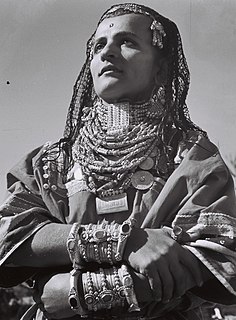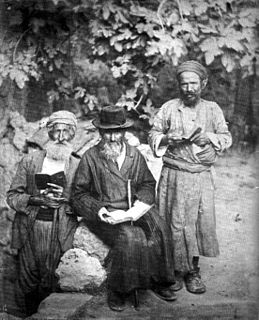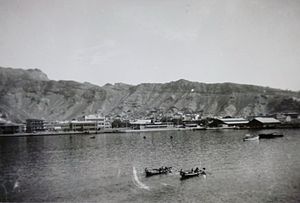
The Jewish exodus from Arab and Muslim countries, or Jewish exodus from Arab countries, was the departure, flight, expulsion, evacuation and migration of 850,000 Jews, primarily of Sephardi and Mizrahi background, from Arab countries and the Muslim world, mainly from 1948 to the early 1970s. The last major migration wave took place from Iran in 1979–80, as a consequence of the Iranian Revolution.

Yemenite Jews or Yemeni Jews or Teimanim are those Jews who live, or once lived, in Yemen. The term may also be used in reference to the descendants of the Yemenite Jewish community. Between June 1949 and September 1950, the overwhelming majority of Yemen's Jewish population was transported to Israel in Operation Magic Carpet. After several waves of persecution throughout Yemen, the vast majority of Yemenite Jews now live in Israel, while smaller communities live in the United States and elsewhere. Only a handful remain in Yemen. The few remaining Jews experience intense, and at times violent, anti-Semitism on a daily basis.

The 1920 Nebi Musa riots or 1920 Jerusalem riots took place in British-controlled part of Occupied Enemy Territory Administration between Sunday, 4 and Wednesday, 7 April 1920 in and around the Old City of Jerusalem. Five Jews and four Arabs were killed, and several hundred were injured. The riots coincided with and are named after the Nebi Musa festival, which took place every year on Easter Sunday, and followed rising tensions in Arab-Jewish relations. The events came shortly after the Battle of Tel Hai and the increasing pressure on Arab nationalists in Syria in the course of the Franco-Syrian War.

Yahya Muhammad Hamid ed-Din became Imam of the Zaydis in 1904 after the death of his father, Muhammad Al-Mansur, and Imam of Yemen in 1918. His name and title in full was "His majesty Amir al-Mumenin al-Mutawakkil 'Ala Allah Rab ul-Alamin Imam Yahya bin al-Mansur Bi'llah Muhammad Hamidaddin, Imam and Commander of the Faithful".

Farhud was the pogrom or "violent dispossession" carried out against the Jewish population of Baghdad, Iraq, on June 1–2, 1941, immediately following the British victory in the Anglo-Iraqi War. The riots occurred in a power vacuum following the collapse of the pro-Nazi government of Rashid Ali while the city was in a state of instability. The violence came immediately after the rapid defeat of Rashid Ali by British forces, whose earlier coup had generated a short period of national euphoria, and was fueled by allegations that Iraqi Jews had aided the British. Over 180 Jews were killed and 1,000 injured, and up to 300–400 non-Jewish rioters were killed in the attempt to quell the violence. Looting of Jewish property took place and 900 Jewish homes were destroyed.

The 1947 Jerusalem Riots occurred following the vote in the UN General Assembly in favour of the 1947 UN Partition Plan on 29 November 1947.

Aden Colony, also the Colony of Aden, was a British Crown colony from 1937 to 1963 located in the south of contemporary Yemen. It consisted of the port of Aden and its immediate surroundings.

Operation Magic Carpet is a widely known nickname for Operation On Wings of Eagles, an operation between June 1949 and September 1950 that brought 49,000 Yemenite Jews to the new state of Israel. During its course, the overwhelming majority of Yemenite Jews – some 47,000 from Yemen, 1,500 from Aden, as well as 500 from Djibouti and Eritrea and some 2,000 Jews from Saudi Arabia– were airlifted to Israel. British and American transport planes made some 380 flights from Aden. At some point, the operation was also called Operation Messiah's Coming.

Adeni Jews, or Adenite Jews are the historical Jewish community which resided in the port city of Aden. Adenite culture became distinct from other Yemenite Jewish culture due to British control of the city and Indian-Iraqi influence as well as recent arrivals from Persia and Egypt. Although they were separated, Adeni Jews depended on the greater Yemenite community for spiritual guidance, receiving their authorizations from Yemeni rabbis. Virtually the entire population emigrated from Aden between June 1947 and September 1967. As of 2004, there were 6,000 Adenites in Israel, and 1,500 in London.

The history of the Jews in the Arabian Peninsula dates back to Biblical times. The Arabian Peninsula is defined as including the present-day countries of Bahrain, Kuwait, Oman, Qatar, Saudi Arabia, United Arab Emirates and Yemen politically and parts of Iraq and Jordan geographically.
Tudor Parfitt is a British historian, writer, broadcaster, traveller and adventurer. He specialises in the study of Jewish communities around the world, particularly in Africa, Asia and the Americas. Some of these communities have been recognised only since the late 20th century as having ancient Jewish origins.
The Aden Protectorate Levies (APL) were an Arab military force raised for the local defence of the Aden Protectorate under British rule. The Levies were drawn from all parts of the Protectorate and were armed and officered by the British military. They used the Lahej emblem of crossed jambiyah as their badge.

The 1834 looting of Safed was prolonged attack against the Jewish community of Safed, Ottoman Empire, during the 1834 Peasants' Revolt. It began on Sunday June 15, the day after the Jewish holiday of Shavuot, and lasted for the next 33 days. Most contemporary accounts suggest it was a spontaneous attack which took advantage of a defenceless population in the midst of the armed uprising against Egyptian rule. The district governor tried to quell the violent outbreak, but failed to do so and fled. The event took place during a power vacuum, whilst Ibrahim Pasha of Egypt was fighting to quell the wider revolt in Jerusalem.

The 1947 anti-Jewish riots in Aleppo were an attack on Syrian Jews in Aleppo, Syria in December 1947, following the United Nations vote in favour of partitioning Palestine. The attack, a part of an anti-Jewish wave of unrest across the Middle East and North Africa, resulted in some 75 Jews murdered and several hundred wounded. In the aftermath of the riots, half the city's Jewish population fled the city.

In the wake of the 1947–48 Civil War in Mandatory Palestine, a riot against the Jewish community of Manama, in the British Protectorate of Bahrain, on December 5, 1947. A mob of Iranian and Trucial States sailors ran through the Manama Souq, looted Jewish homes and shops, and destroyed the synagogue. One Jewish woman died; she was either killed or died from fright.

Lebanese Jewish Migration to Israel included thousands of Jews, who moved to Israel, similar to how 1948 witnessed the emigration of hundreds of thousands of Jews from Arab countries. Yet, "unlike Jewish communities in many other Arab states, the Jewish communities in Lebanon grew after 1948 and it was not until the end of the civil war of 1975 that the community started to emigrate." This "Lebanese difference" derives from two components: more positive Lebanese relationships with European authorities during the French Mandate than experienced by other Arab states, leading to a more pluralistic outlook in Lebanon than its neighbors; some elements in the Maronite Christian community who were tolerant of Zionism.

Mandatory Palestine was a geopolitical entity established between 1920–1948 in the region of Palestine under the terms of the League of Nations Mandate for Palestine.

Yemenite Jews in Israel are immigrants and descendants of the immigrants of the Yemenite Jewish communities, who now reside within the state of Israel. They number around 400,000 in the wider definition. Between June 1949 and September 1950, the overwhelming majority of Yemen and Aden's Jewish population was transported to Israel in Operation Magic Carpet.

In the early years before the immigration to Israel the Jewish community of Saada was numbered around 1000 people.
The 1934 Constantine riots was an anti-Jewish riot that erupted in the Algerian city of Constantine. The events have also been described as a pogrom.















